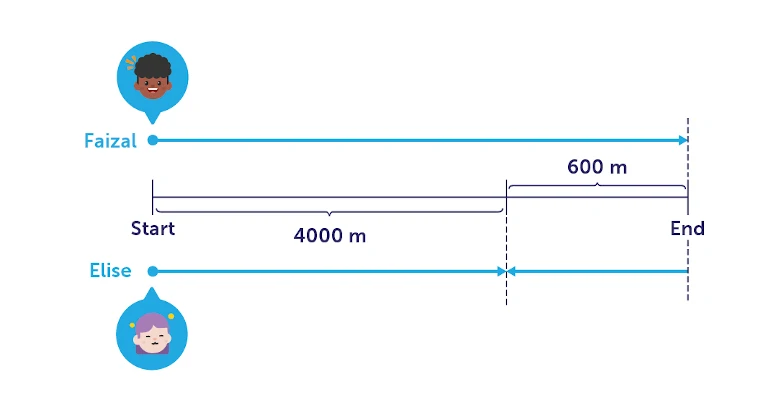Solving challenging 2023 PSLE Maths questions: Faizal and Elise Jogging question
- Tags:
- Primary Maths

When it comes to mastering challenging maths problems, the 2023 Primary School Leaving Examination (PSLE) has certainly set the bar high. One such challenging question that has been a topic of discussion among students and educators alike is the "Faizal and Elise's Jogging Question."
In this article, we will delve into the details of this problem, providing a comprehensive solution that will help you understand how to solve such questions.
PSLE 2023 Faizal and Elise jogging question on speed
Question:
Faizal and Elise started jogging from the same spot at the same time. Faizal's speed was \(30 \text{ m/min}\) faster than that of Elise's. Both of them did not change their speed throughout the jog. Faizal jogged all the way to the end of the track and immediately made a U-turn. They passed each other at the \(\text{4000-m}\) mark of the track. What was Elise's speed?
The question also included a diagram (As seen above) illustrating that Faizal ran an additional \(\text{600 meters}\) before turning back and covering the same distance before overtaking Elise.
Solution:
Let's look at the question. What information do we have?
- Faizal and Elise started jogging from the same spot at the same time.
- Faizal's speed was \(30 \text{ m/min}\) faster than that of Elise's. Or, for every minute that Elise jogged, Faizal ran \(\text{30 meters}\) more than her.
- Neither Faizal nor Elise changed the speed throughout their jog.
- Faizal jogged all the way to the end of the track and immediately made a U-turn. They passed each other at the \(\text{4000-m}\) mark of the track.
After knowing all of this, we are required to solve what was Elise's speed.
Do you remember your Speed-Distance-Time formula? It's time to apply it to this question.
We know that \(\displaystyle{\mathrm{Speed= \frac{Distance}{Time}}}\).
So, to find Elise's speed, we need to know:
- The distance that she covered.
- The time she took to run.
Now, let's look at the question again.
"They passed each other at the \(\text{4000-m}\) mark of the track"
This means that Elise had jogged for \(\text{4000 meters}\) when Faizal passed her.
Now this is where the question becomes tricky. The question does not tell us the time Elise took to reach this \(\text{4000-m}\) mark.
Let's look for clues from the question.
We know that Faizal's speed was \(30 \text{ m/min}\) faster than that of Elise.
We also know that Faizal ran \(\text{600 m}\) one way, turned around and ran \(\text{600 m}\) before he passed Elise.
This means that Faizal ran \(\text{1200 meters}\) more than Elise \((600\times2=1200)\) in the amount of time that Elise took to run \(\text{4000 meters}\).
Now, to find how much time Faizal took to jog, we need to calculate \(\displaystyle{\mathrm{\frac{Distance}{Time}}}\).
Which is \(\displaystyle{\mathrm{{1200\over30}=40}}\) minutes.
This means, Faizal took \(\text{40 minutes}\) to run \(\text{1200 m}\).
So, Elise must have taken \(\text{40 minutes}\) to reach the same point!
Now, we have the time Elise took to run \(\text{4000 m}\).
Putting all of the information in the formula \(\displaystyle{\mathrm{Speed= \frac{Distance}{Time}}}\).
Elise's Speed \(\displaystyle{= \mathrm{4000\over 40} = 100 \text{ m/min}}\)
That's it, we have our answer!
Elise's speed is \(100 \text{ m/min}\).


 SG
SG  VN
VN 



















